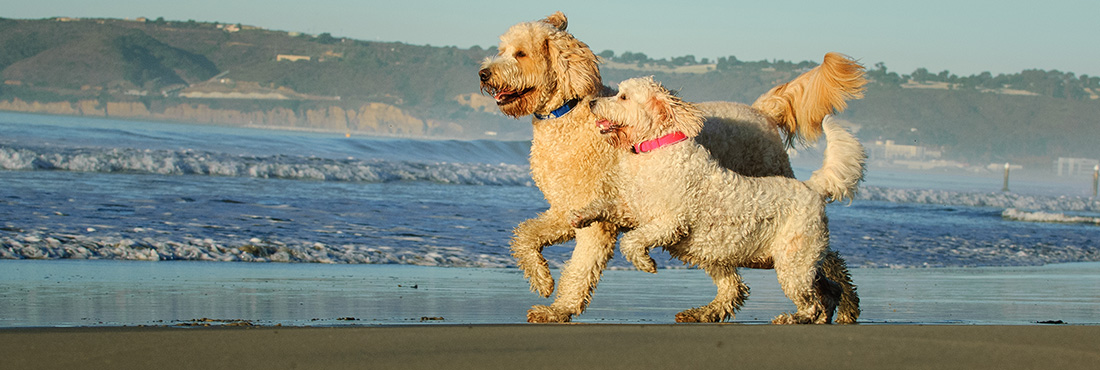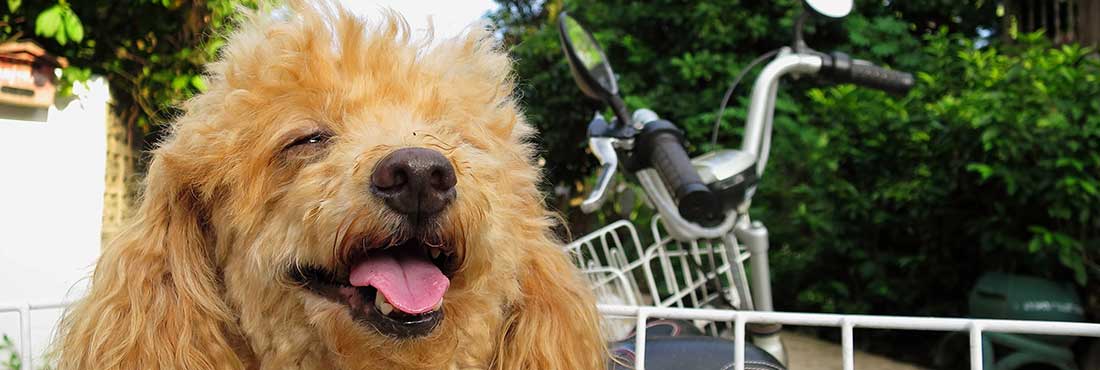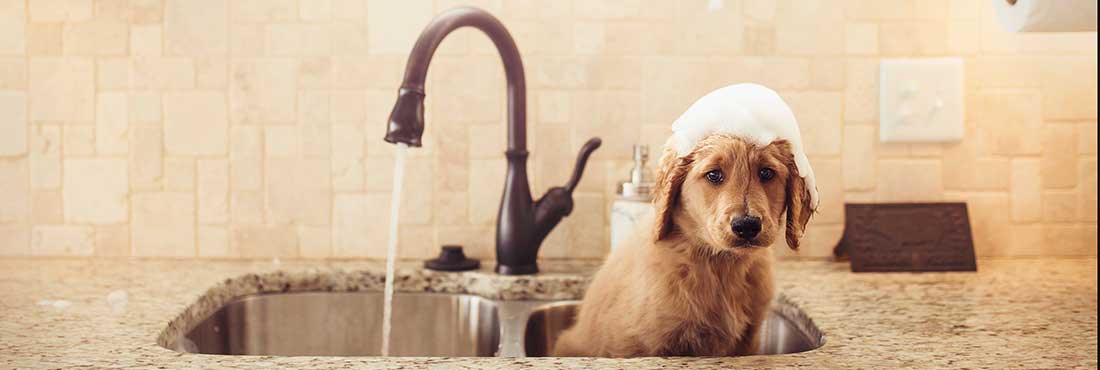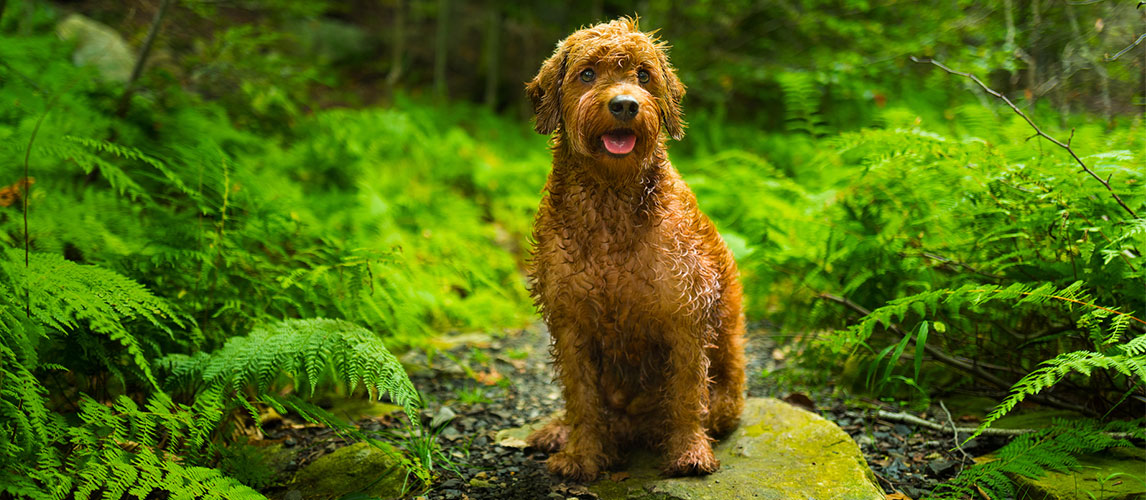The Red Goldendoodle pup is one of many hybrid dogs in the world. To get a Goldendoodle puppy, you must cross a Golden Retriever parent with a Poodle parent. The red coat of a Red Goldendoodle is a little more challenging to achieve because it requires selective breeding. Your Red Goldendoodle will likely have the genes for a red coat somewhere in their DNA – whether this is from one of the parent breeds having a red coat color or because of a genetic mutation.
In this guide, we’ll tell you all you need to know to care for a Red Goldendoodle and where to find Red Goldendoodle puppies for sale. Read on to learn more about Red Goldendoodle dogs.
Red Goldendoodle Basics
| Height | Weight | Lifespan | Personality | Parent breeds | Origin |
|---|---|---|---|---|---|
| 21 to 24 inches | 45 t0 75 pounds | 10 to 15 years | Friendly, gentle, protective | Red Purebred Poodle and Purebred Golden Retriever, or two Red Goldendoodles, or a Red Goldendoodle and a Red Purebred Poodle | Australia and the United States of America |
Where do Red Goldendoodles Come from?
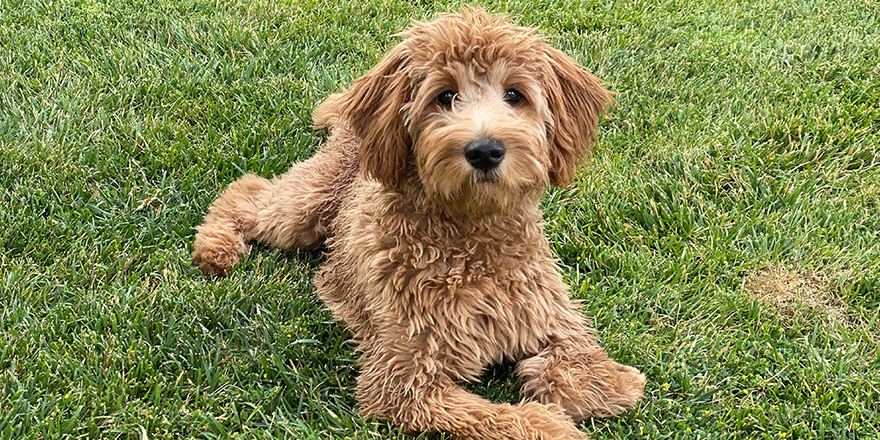
While the exact history of the Red Goldendoodle remains unknown, we know that the Goldendoodle breed started gaining popularity around the 1990s. With their curly coats and friendly nature, it’s no wonder that they were considered such lovely hybrid dogs.
It’s said that the Goldendoodle was possibly bred by Wally Conron of the Royal Guide Dog Association of Australia, but there’s a lot of mixed information about this, and one can’t be certain that he was the first to breed a Goldendoodle.
Because of the misinformation and lack of written records about the breed, there’s no way to tell when the Goldendoodle first came around or when dark-colored Poodles with red coats started being bred with Golden Retriever dogs to create Red Goldendoodles.
Breeding Goldendoodles: How Red Goldendoodles are Produced
Breeders looking to produce Goldendoodles will continue to breed them over several generations to gain the desired characteristics that they’re looking for from the dogs. Some Goldendoodles will even be backcrossed with the parent breeds (meaning that a Goldendoodle is bred with a Poodle) to try and gain certain traits that the current dogs don’t have.
There are six major types of Red Goldendoodle.
- Red F1 Goldendoodle – Bred from a red purebred Poodle and a purebred Golden Retriever. These are 1st generation Red Goldendoodles, and their height and weight will vary depending on the size of their parents. The Standard Red Goldendoodle from the F1 type will be 21 to 24 inches and 45 to 75 pounds. There are also Medium and Mini variations.
- Red F1b Goldendoodle – This version results from backcrossing an F1 Goldendoodle with a Golden Retriever or a Poodle. The Standard version of this variation is a little smaller than an F1 Goldendoodle, with a height of around 21 inches and a weight of 40 pounds. Again, there are Medium and Minis of this variation, too.
- Dark Red F1b Goldendoodle – Likely created because coat colors are often diluted when a Red Poodle is mixed with a Golden Retriever to make Red Doodles, the Dark Red Goldendoodle is a Red Goldendoodle backcrossed with a Red Poodle to regain the color lost and give the puppies a more vibrant red coat.
- Red F1bb Goldendoodle – A category for Red Goldendoodles that have been backcrossed twice with a purebred Poodle.
- Red F2 Goldendoodle – The 2nd generation puppy of two F1 Goldendoodles.
- Red F2b Goldendoodle – Produced when an F2 Goldendoodle is backcrossed with a Poodle.
Can You Get Mini Red Goldendoodle Puppies?
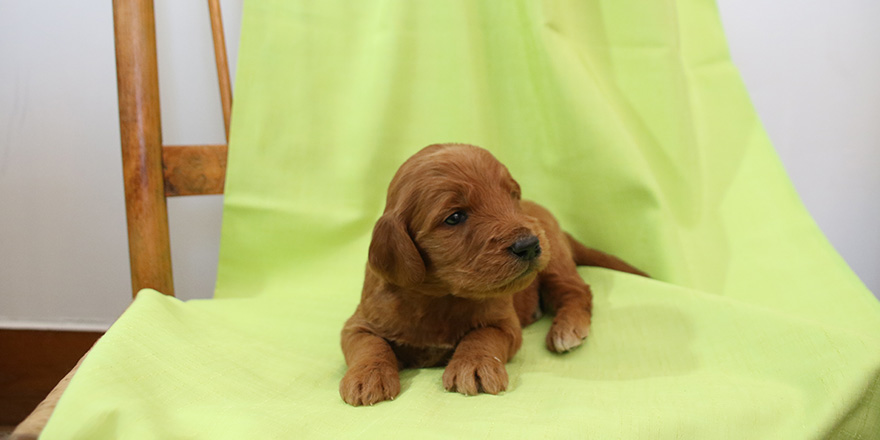
The Red mini Goldendoodle is a possible breed variation, but you should expect them to be pricier and harder to find. This is because a miniature Red Goldendoodle can only be made when a mini Poodle is one of the parents. Even then, there’s a possibility that the Red Goldendoodle puppies will be full-sized. The “mini” aspect of any dog breed is down to selective breeding. Producing dogs of a tiny size is the result of matching runts of litters together and then just hoping for the best. There’s no genetic mutation for a “mini” dog. They’re just naturally small or bred that way.
It can be incredibly unhealthy for the mini variant in question. Dogs aren’t supposed to be so small, and tiny dogs often have health issues throughout their life. Before you go mini, we highly suggest you research more about the world of mini dog breeds and what owning one might entail.
What Other Types of Red Goldendoodle are There?
There are several variations of Red Goldendoodle in terms of size. There are:
- Standard Red Goldendoodles may be up to 24 inches tall and weigh 75 pounds.
- Moyen or Medium Red Goldendoodles grow up to 20 inches and 45 pounds.
- Mini Red Goldendoodles may grow up to 15 inches and 30 pounds.
- Toy Red Goldendoodles are around 11 inches and weigh under 15 pounds.
- Red Micro Mini Goldendoodles measure between 10 and 12 inches and weigh between 5 and 10 pounds. There’s some crossover with the Toy size version of these dogs, so the best way to tell them apart is the weight once they are fully grown.
- Red Petite Goldendoodle is bred by adding Cocker Spaniel genetics into the mix. They come in several sizes, but the Petite version is the most popular, with the dog being between 10 and 18 inches and weighing between 15 and 40 pounds.
- Red Teacup Goldendoodles are the absolute smallest Red Goldendoodle. They grow no taller than 9 inches and weigh under 6 pounds.
What is the Difference Between Goldendoodle Colors?
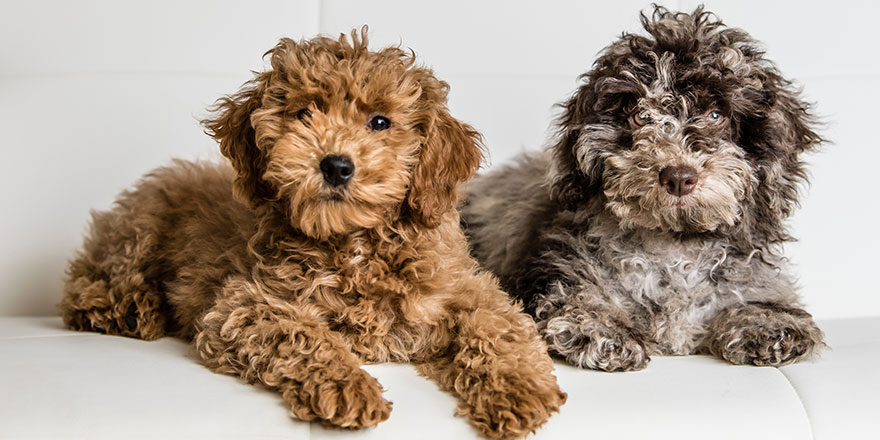
The most basic difference is coat color genetics. Red Goldendoodles are just a color variation on other breed coat colors. Goldendoodles are more often gold in color because the gold tone of their coat is desirable and easier to get (thanks to their Golden Retriever parents).
Goldendoodle dogs with a more vibrant red coat may have parents that were backcrossed (a Red Goldendoodle being crossed with a Red Poodle). This is standard practice to get dark coats in Red Goldendoodles because crossing a Red Poodle with a Golden Retriever can create Goldendoodle puppies with lighter-colored coats.
The color range in Goldendoodles comes from the coat colors of their parents. If a Goldendoodle had a dark-colored Poodle as a parent, they could have a darker coat, while Goldendoodles with light-colored Poodle and Golden Retriever parents are more likely to be cream or light gold.
Red Goldendoodle Coat Colors and Pattern Variations
- Dark Red Goldendoodle (mahogany coat color)
- Fox Red Goldendoodle (light ginger coat color with patches of white)
- Imperial Red Goldendoodle (mid to dark ginger coat color)
- Light Red Goldendoodle (light ginger coat color)
- Red Abstract Goldendoodle (Dark patchy red coat color with sections of white)
- Red Apricot Goldendoodle (light ginger coat color with some darker and lighter patches)
- Red Merle Goldendoodle (irregular patches of dark and light red, white, and possibly brown)
- Red Parti Goldendoodle (Part red, part white coat)
- Red Sable Goldendoodle (ombre effect across red coat)
- Red Tuxedo Goldendoodle (red coat with white tuxedo pattern)
- Red and White Goldendoodle (red and white coat colors in any pattern)
- Red and White Abstract Goldendoodle (red and white irregular patches across the entire coat)
- Red and White Parti Goldendoodle (part red, part white, more likely to be mid/light ginger than dark red)
Grooming Your Goldendoodle
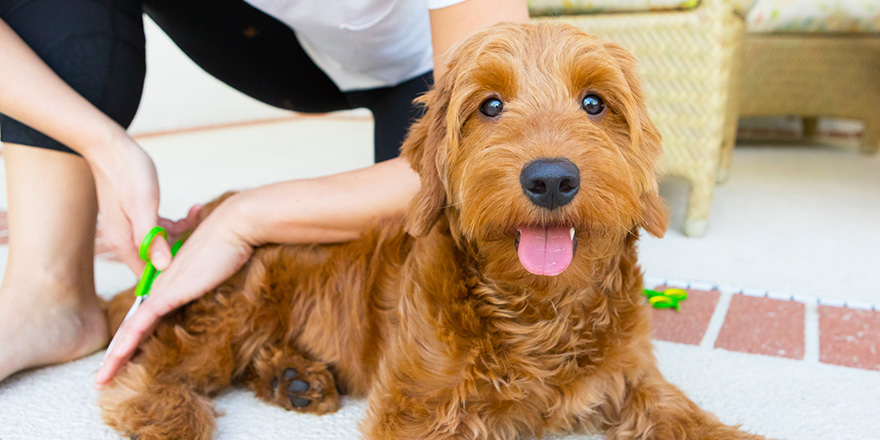
Because some Goldendoodles have curly coats, grooming them can take a little more effort than the occasional brush and bath. Like other dogs, start by giving your Red Goldendoodle a good brush. You might need some dog-safe detangler, depending on the hair type that your Doodle has.
Use a slicker brush to work through your dog’s coat. Slicker brushes are great for all types of dogs and cats, and the bristles won’t get stuck in your pup’s fur. You can get any trapped debris out of their coat by brushing your dog.
You may occasionally come across a knot that won’t come out. When this happens, it’s better to remove the tangle with a clipper than try to force it to come undone. A quick clip-on fur that will soon grow back is better than making your pup uncomfortable.
After brushing, then bathe your dog. Dogs don’t need to be bathed often, but they appreciate a warm bath. Remember to use a dog-safe shampoo appropriate for your dog’s hair type. Shampoo for curly-haired dogs is available and great for Doodles with the teddy bear look.
Following their bath, simply dry off your pup with a towel. Unless you have experience or have closely followed the advice of a groomer, we wouldn’t recommend trying to trim your Goldendoodle’s coat at home.
Are Red Goldendoodles Hypoallergenic?
No true hypoallergenic dog breeds exist, but the happy-go-lucky Goldendoodle is less likely to set off allergies. When it comes to dog allergies, what the human is experiencing is usually an allergy to the pollen in the dog’s fur or saliva.
If you’re looking for a dog and have known dog allergies, a Goldendoodle puppy could be a good alternative to other dog breeds. We cannot give medical advice or advise you on what kind of dog to get, but this breed doesn’t seem to get as many reactions as others.
When in doubt, consider spending time with a Goldendoodle that someone local to you has, or even go and check some out that a reputable breeder has for sale. Stay for a while and see if your allergies act up.
Common Health Issues for Red Goldendoodles
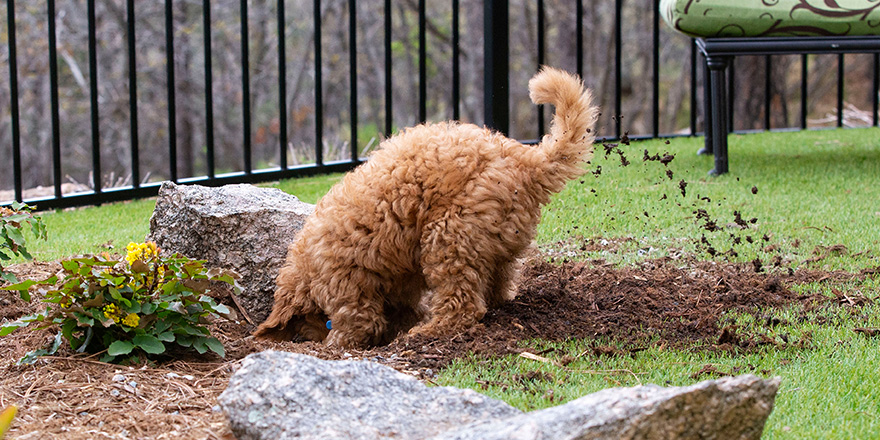
Red Goldendoodles are great family dogs. They have a soft coat, a cute teddy bear appearance, and are extremely friendly. However, like all dogs, they do have a few common health or medical issues that new owners should be made aware of. These are the most common conditions seen in the Red Teddy Bear Goldendoodle and all other Red Goldendoodle variations:
- Addison’s Disease
- Cancer
- Cataracts
- Ear infections
- Glaucoma
- Hip Dysplasia
- Patellar Luxation
- Progressive Retinal Atrophy
- Sebaceous Adenitis
- Subvalvular Aortic Stenosis
- Von Willebrand’s Disease
It may seem like many serious conditions, but there’s a reason for them. Goldendoodle puppies inherit their health conditions from their parents, which means that the common health conditions for Golden Retrievers and Poodles are also seen in Goldendoodles.
What to Feed your Red Goldendoodle
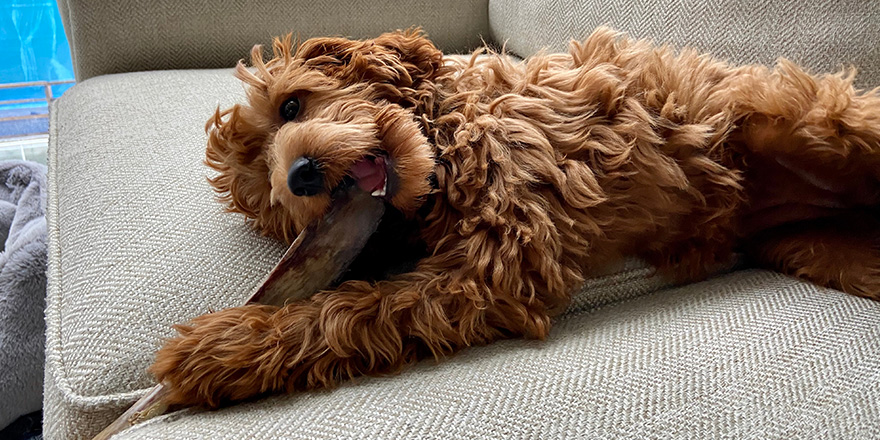
Dog food baffles a lot of first-time dog owners. There are so many brands and a huge range of options in each brand that it can be overwhelming. You can easily cut down your options by taking a quick peek at the ingredients! Avoid any dog food that uses “by-products”, meat or fish “meal”, adds salt, or has ingredients that aren’t fully disclosed (such as using the term “animal protein” without explaining what that means).
Try to buy from more wholesome dog food brands and research common dog allergens. Many smaller brands won’t be found in grocery or pet stores but are often sold on marketplace websites like Chewy and Amazon. Always read the reviews before you make your final decision, and remember that dogs with sensitive stomachs or allergies may need a special diet.
A quick bit of advice: For dogs prone to joint issues, try to buy food that adds appropriate supplements. For dogs, the correct supplements for joint health include Glucosamine, Chondroitin, and MSM. Glucosamine is probably the most common one added to dog food.
For more Red Goldendoodle dietary requirements, you’ll need to pay attention to what affects your dog. It can be tempting to buy more affordable dog food for standard Red Goldendoodle puppies and full-grown Red Goldendoodle adults, but cheap dog food won’t offer the best nutrition for your pup. Treat your teddy bears as you would want to be treated!
Frequently Asked Questions
The rarest color of Goldendoodle is the Black Goldendoodle. This is because it's nearly impossible to get a Black Goldendoodle puppy from a Golden Retriever parent unless both the Retriever and the Poodle parent have the recessive black coat color gene in their genetics. Red Goldendoodles, in comparison, are much easier to breed, though not as common as Gold Goldendoodles. A Red Golden Doodle can be produced by simply breeding a Red Poodle and a Golden Retriever.
A Goldendoodle puppy can cost anywhere from $2,000 to $5,000 USD. Red Goldendoodles aren't as common as Gold Goldendoodles, but they aren't as rare as Black Goldendoodles, so you can approximate that a Red Goldendoodle puppy will fall somewhere in the middle if their pedigree holds up. Some breeders may sell them for cheaper if they've come from a large litter, so you could get lucky and find a Red Doodle around $1,200 to $1,500. Only buy from trusted and verified breeders.
You aren't likely to find this breed up for adoption in any local shelter because they are considered a designer hybrid dog and are expensive to buy. To add your own Red Goldendoodle to your family, you'll need to look at reputable breeders and be very careful about each stage of the process. Never pay a deposit online, always meet the pup in question and ask for vet records, meet the parent dogs, and don't pay in full until the moment you're about to take the dog home.
Remember that Red Goldendoodles must have one of the following sets of parents:
- A Red purebred Poodle and a purebred Golden Retriever
- Two Red Goldendoodles
- A Red Goldendoodle and a Red purebred Poodle
It's possible for other color combinations of these three breeds to create a Red Goldendoodle, but that could affect the dog's coat color vibrance as they grow if the Red gene is recessive.
Experiencing a Goldendoodle color change? The mystery of the red and white Goldendoodle isn't so much a mystery as it is a sign of growing up. Goldendoodles often change color as they grow, and it's normal for adorable Red Goldendoodles to experience some fur lightening as they age. This is the same for any pattern variation, including the Red Sable Goldendoodle, and the Red Tuxedo Goldendoodle. This lightening phenomenon is one of the reasons that breeders will backcross Red Goldendoodles with Red Poodles, to try and retain the fur color in the pup.


